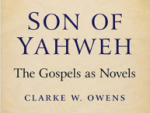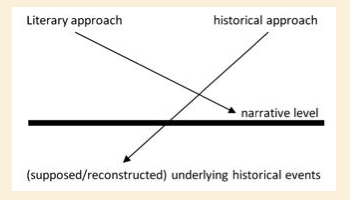 This post is best read in the context of the earlier posts on Clarke Owens’ Son of Yahweh: The Gospels as Novels, in particular Jesus Is Not “As Historical As Anyone Else in the Ancient World”. This post considers the different genres qualities (verbal categories, discourse types) between Gospels and historical writings and concludes the Gospels are characterized by language typical of make-believe narratives. This post is best read in the context of the earlier posts on Clarke Owens’ Son of Yahweh: The Gospels as Novels, in particular Jesus Is Not “As Historical As Anyone Else in the Ancient World”. This post considers the different genres qualities (verbal categories, discourse types) between Gospels and historical writings and concludes the Gospels are characterized by language typical of make-believe narratives. |
.
One would expect that it would go without saying that one must first understand what one is reading before one knows how to assess its value as a historical source. But the field of historical Jesus research is graced with many exceptions and methods found in no other field of historical inquiry. One of these is the belief that literary analysis has no relevance to the study of the historical Jesus.
James McGrath even publishes a diagram to show why literary analysis is irrelevant for historical inquiry. It is assumed that the literary approach does nothing more than explain the literary qualities and narrative structure of the work. It appears in The Burial of Jesus: History and Faith:
 .
.
McGrath is not alone in this understanding of the difference between literary and historical studies of the Gospels, which is to say that a good number of Christian history scholars do not really understand the nature of historical source material or the fundamentals of how to undertake historical research. I am not saying all biblical scholars fall into this trap, nor that all other types of historians avoid it, since there are indeed a few biblical scholars more critical than their peers and some sloppy historians in other fields who build upon unexamined assumptions.
 Jack Miles (born 1942) is an American author and winner of both the Pulitzer Prize and the MacArthur Fellowship. His work on religion, politics, and culture has appeared in numerous national publications . . . . Miles treats his biblical subjects neither as transcendent deities or historical figures, but as literary protagonists. His first book, God: A Biography, won the Pulitzer Prize for Biography in 1996 . . . . (Wikipedia)
Jack Miles (born 1942) is an American author and winner of both the Pulitzer Prize and the MacArthur Fellowship. His work on religion, politics, and culture has appeared in numerous national publications . . . . Miles treats his biblical subjects neither as transcendent deities or historical figures, but as literary protagonists. His first book, God: A Biography, won the Pulitzer Prize for Biography in 1996 . . . . (Wikipedia)What is wrong with the above model? Jack Miles, another scholar discussed by Clarke Owens in Son of Yahweh: The Gospels as Novels, strongly disagrees with the notion that one can validly “see through” the Gospel narratives to history below. He draws the analogy of the text as a stained-glass window: not to be looked through but looked at. According to Clarke Owens this is only “half right”. Owens identifies the flaw in Jack Miles’ analogy: Miles is embracing as a universal what “literary critics would recognize as [only] a theory” of literature — that of “autotelic literature“. That is, the idea that literature can and must be interpreted only within its own boundaries is only one theory among a number of valid ways of reading and understanding literature.
According to Owens, while it is correct that we cannot “look through” a text on the assumption that it is some sort of window to a real world of past persons and events, it must be recognized that there are ways literature can serve as historical sources — only not in the way biblical scholars too often assume.
The message of the stained glass window
Clarke Owens, writing as a literature scholar, reminds us that there are certain types of literature (e.g. allegory) acknowledged as taking their meaning and intended interpretations from reference points outside themselves. (One might call this type heterotelic, referring to something outside itself, as opposed to autotelic.) So Owens disputes the idea of Jack Miles that literature must be read exclusively “as literature” and without reference to history. Continue reading “Gospels As Historical Sources: How Literary Criticism Changes Everything”
